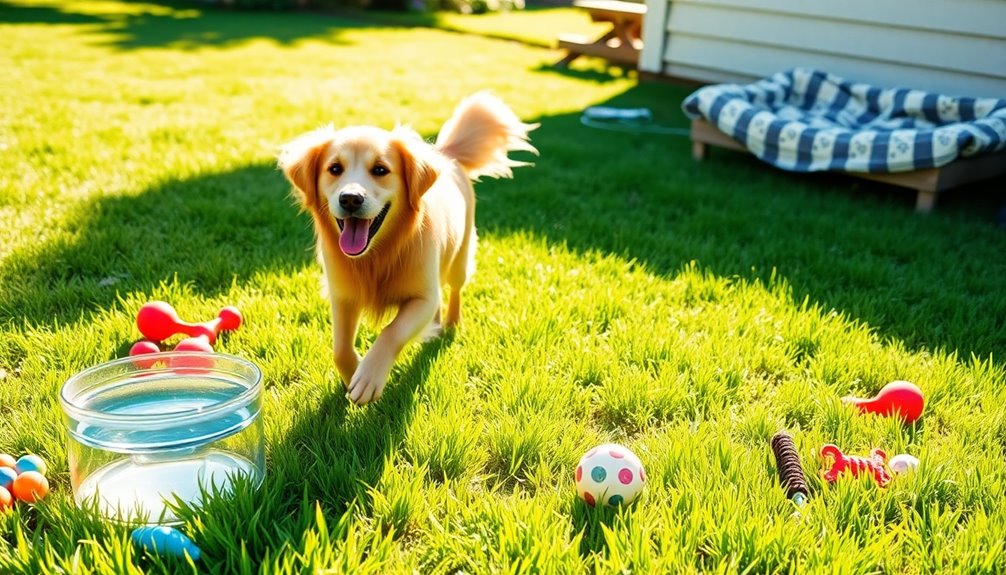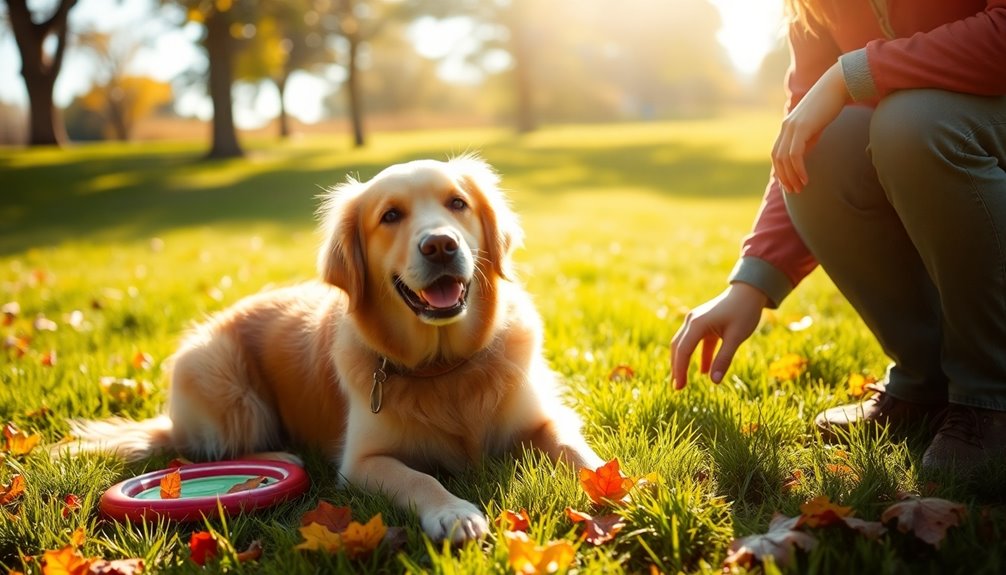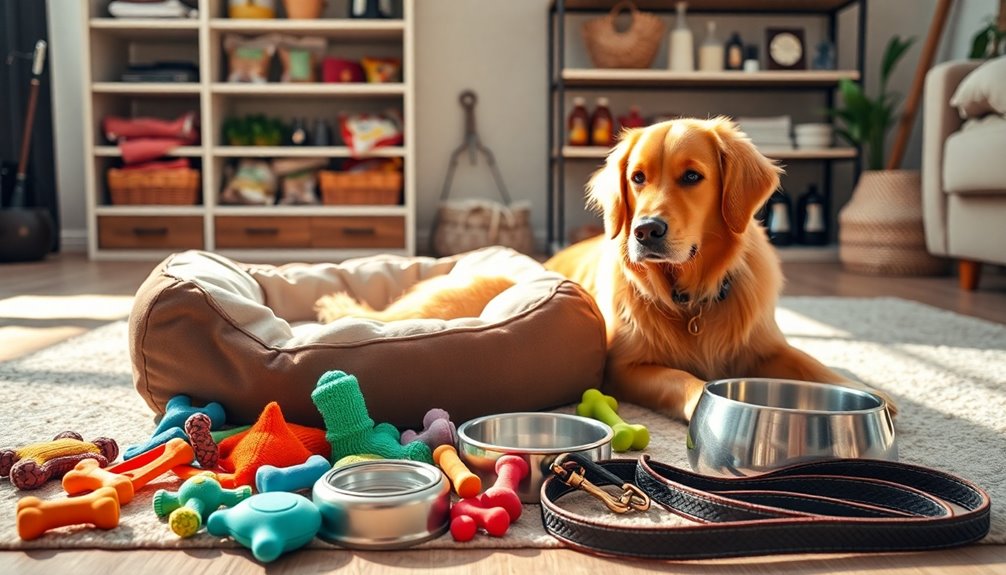You're taking great care of your dog if you notice healthy energy and a shiny coat. Regular vet visits guarantee they're vaccinated and free of health issues. If their nails are trimmed and their coat stays clean, you're on the right track. Daily walks and playful activities keep them fit and mentally engaged. Consistent training with positive reinforcement builds trust and strengthens your bond. When your dog feels included in family activities, they know they belong. These signs show your dedication, but there's plenty more to explore about enhancing your pup's life.
Key Takeaways
- Your dog maintains a healthy weight and shows good energy levels, indicating proper nutrition and regular exercise.
- Regular veterinary visits ensure your dog is up-to-date on vaccinations and free from health issues.
- Your dog has a shiny, well-groomed coat, showing consistent grooming practices and overall good health.
- Engaging in daily play and social activities keeps your dog mentally stimulated and emotionally fulfilled.
- Your dog responds well to basic commands, indicating effective training and a strong bond between you.
Regular Veterinary Check-Ups

Regular veterinary check-ups are vital for your dog's health and well-being. These visits help detect health issues early, ensuring any potential problems are addressed before they escalate into serious conditions. During these appointments, your vet can administer annual vaccinations that protect against preventable diseases, greatly reducing the risk of illness for your furry friend.
Additionally, regular veterinary check-ups often include dental assessments, which are essential for preventing periodontal disease that can lead to further health complications. Monitoring your dog's weight and nutrition during these visits helps maintain a healthy body condition and prevents obesity-related issues, which are becoming increasingly common.
You'll also establish a health history for your dog through consistent visits, providing valuable information for future care and treatment decisions. Being proactive about your dog's overall health shows you're attentive to the signs your dog may need medical attention.
Regular check-ups are a fundamental part of responsible dog ownership, ensuring your pet lives a long, healthy life. Don't overlook the importance of these visits—your dog's well-being depends on them!
Proper Nail Care

Nail care is an important aspect of your dog's grooming routine that often gets overlooked. Regular nail trimming is essential for your dog's health and overall comfort.
When nails are too long, they can cause pain and discomfort, making it difficult for your dog to move freely.
Here are some signs that your dog needs proper nail care:
- Long Nails: If you can hear your dog's nails clicking on the floor, it's time for a trim.
- Curling Nails: Curling nails indicate neglect and need immediate attention to prevent health complications.
- Reluctance to Walk: If your dog hesitates to walk or seems uncomfortable, long nails might be the cause.
- Home Damage: If your dog's long nails are scratching your floors or furniture, it's a sign that you need to address nail care.
Well-Groomed Coat
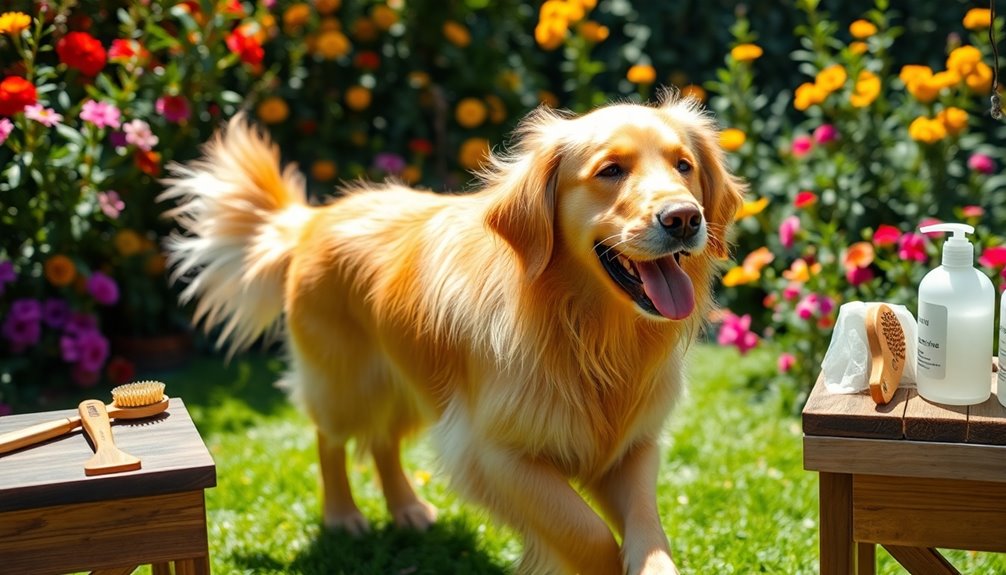
A well-groomed coat not only looks great but also plays an essential role in your dog's overall health and comfort. Regular grooming sessions help keep your dog's coat clean, shiny, and free of mats. This is important for their hygiene and comfort.
Dogs need consistent brushing to remove dead hair and allergens, which prevents matting and promotes a healthy coat. Depending on the breed, you might need to brush several times a week.
Bathing your dog with dog-specific products, tailored to their coat type, is also important for maintaining coat health and preventing skin irritations. If you notice a dull or rough coat, it might indicate dietary issues or allergies, signifying that a balanced diet rich in essential nutrients is crucial for your dog's health. Additionally, including safe fruits like apples in their diet can contribute to a shiny coat and overall vitality.
Moreover, consistent grooming allows you to detect skin problems early, ensuring your dog remains comfortable and healthy. By prioritizing your dog's grooming routine, you're not just enhancing their appearance; you're actively contributing to their overall well-being.
Adequate Physical Exercise
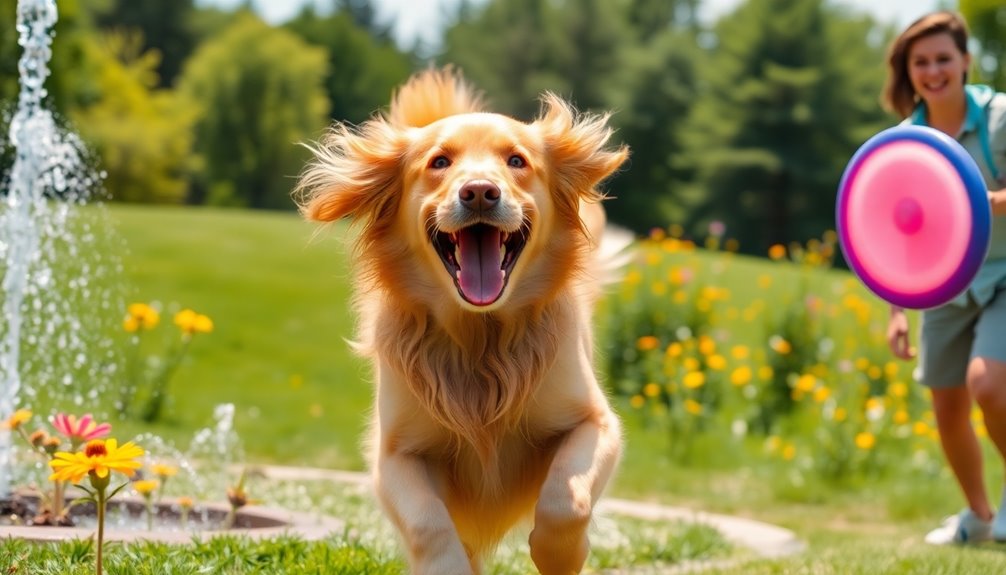
To keep your dog healthy and happy, regular walks of at least 30 minutes a day are essential.
Engaging in playtime activities like fetch or agility exercises not only boosts their fitness but also strengthens your bond.
Mixing up exercise routines with hiking, swimming, or running helps keep their mind sharp and prevents boredom.
Regular Walks Scheduled
Regular walks are essential for maintaining your dog's physical and mental well-being. Daily walks help keep your dog healthy, maintain a healthy weight, and reduce the risk of obesity-related diseases.
To guarantee your dog gets enough exercise, aim for at least 30 minutes to 2 hours of walking each day, depending on their breed, age, and energy level.
Here are some tips for making the most of your regular walks:
- Vary the routes: Change your walking paths to expose your dog to new sights and smells, stimulating their mental health.
- Incorporate playtime: Use walks as an opportunity for play, like fetching a ball or allowing off-leash time in safe areas.
- Establish a routine: Consistency in walking can improve your dog's behavior, reducing anxiety and pent-up energy.
- Monitor their energy: Pay attention to your dog's energy levels to adjust the duration and intensity of your walks accordingly.
Engaging Playtime Activities
Engaging your dog in playtime activities is just as important as regular walks for their physical and mental health. Incorporating activities like fetch or agility training into your dog's routine guarantees they receive the necessary exercise and mental stimulation. Aim for at least 30 minutes of active play each day to prevent boredom and behavioral issues, which contributes considerably to your dog's overall happiness.
Mixing up play activities keeps things exciting. Introduce puzzle toys or vary walking routes to enhance their interest in physical exercise. This variety not only stimulates their mind but also keeps them physically engaged.
Playdates with other dogs provide both exercise and essential social skills, helping reduce anxiety. Observing your dog's enthusiasm during playtime is a great indicator of their happiness. If they're wagging their tail and keen to engage, you know you're meeting their physical exercise needs effectively. Additionally, fostering self-regulation through structured playtime can help your dog manage their energy levels and emotions more effectively.
Varied Exercise Routines
While daily walks are essential for your dog's physical health, incorporating varied exercise routines can elevate their fitness and happiness even further. Engaging your dog in diverse activities not only boosts their physical fitness but also enhances their emotional well-being.
Here are four great ways to mix up their exercise routine:
- Fetch: This classic game is perfect for burning off energy and building stamina.
- Agility Training: Set up a simple obstacle course to improve your dog's coordination and mental agility.
- Swimming: If your dog enjoys water, swimming is an excellent low-impact workout that strengthens muscles.
- Hiking: Explore different environments together, which keeps your dog stimulated and helps reduce stress.
Regular walking sessions of at least 30 minutes, combined with these playtime activities, considerably improve your dog's overall behavior.
Variety in exercise not only prevents boredom and behavioral issues but also supports their emotional well-being by encouraging social interactions. Tailoring activities to your dog's energy levels fosters autonomy and helps maintain a healthy weight, ensuring your pup leads a fulfilling life.
Basic Training Knowledge
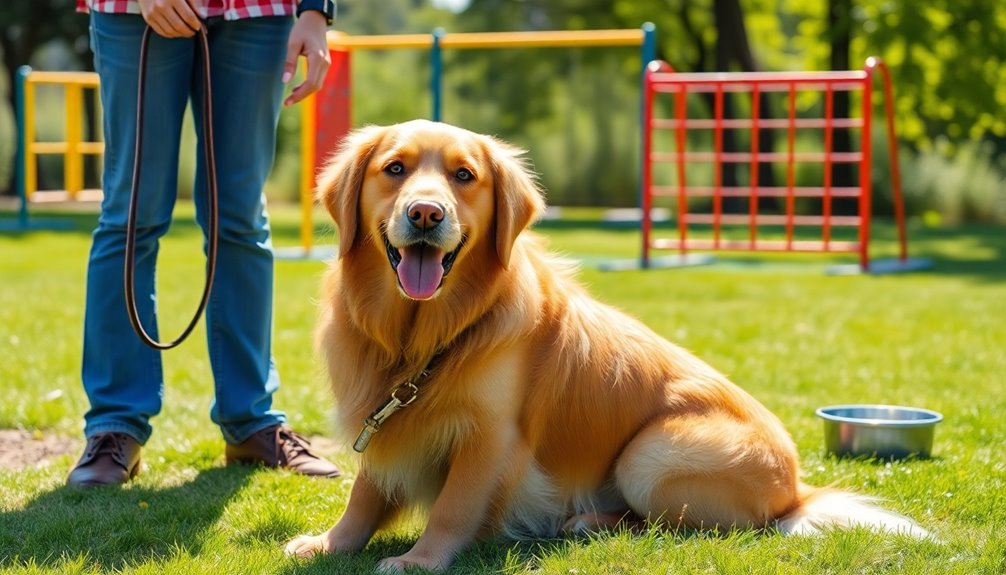
When it comes to your dog's training, mastering essential cues like "sit," "stay," and "come" is key for their safety and your peace of mind.
Using positive reinforcement techniques not only helps your dog learn but also encourages them to repeat good behavior.
Essential Cues Mastered
Mastering essential cues like "sit," "stay," and "come" is vital for your dog's safety and well-being. These commands help prevent potential hazards, like running into traffic, while also fostering a positive environment for training. By ensuring your dog has these essential cues mastered, you show that you're taking care of their needs.
Here are four key benefits of mastering essential cues:
- Safety: Commands like "stay" can keep your dog safe in potentially dangerous situations.
- Bonding: Regular practice strengthens the bond between you and your dog, enhancing your relationship.
- Obedience: Consistent training reinforces good behavior and improves overall obedience.
- Stress-Free Learning: Engaging training sessions make learning enjoyable, encouraging your dog to respond enthusiastically to commands.
Using positive reinforcement during training sessions not only boosts your dog's understanding but also promotes a healthy and happy learning environment.
Prioritizing consistent training is critical, as a lack of basic commands can indicate neglect in your care efforts. Remember, a well-trained dog is a happy and safe companion!
Positive Reinforcement Techniques
Positive reinforcement techniques are essential for effective dog training and can greatly enhance your bond with your furry friend. By rewarding desired behaviors with treats, praise, or play, you encourage your dog to repeat those behaviors. This method not only strengthens your relationship but also helps your dog understand what you expect from them.
To get the best results, focus on the consistent use of clear cues like "sit," "stay," and "come." This clarity promotes better behavior and safety in various situations.
Keep your training sessions short and engaging—ideally lasting no more than 5-10 minutes. This approach helps maintain your dog's focus and enthusiasm, fostering effective learning.
Incorporating positive reinforcement techniques, such as clicker training, can enhance your communication and understanding. This makes it easier for your dog to grasp new commands and behaviors.
Regular practice in different environments will boost your dog's adaptability and confidence, ensuring they respond positively to commands anywhere you go.
Family Engagement and Interaction
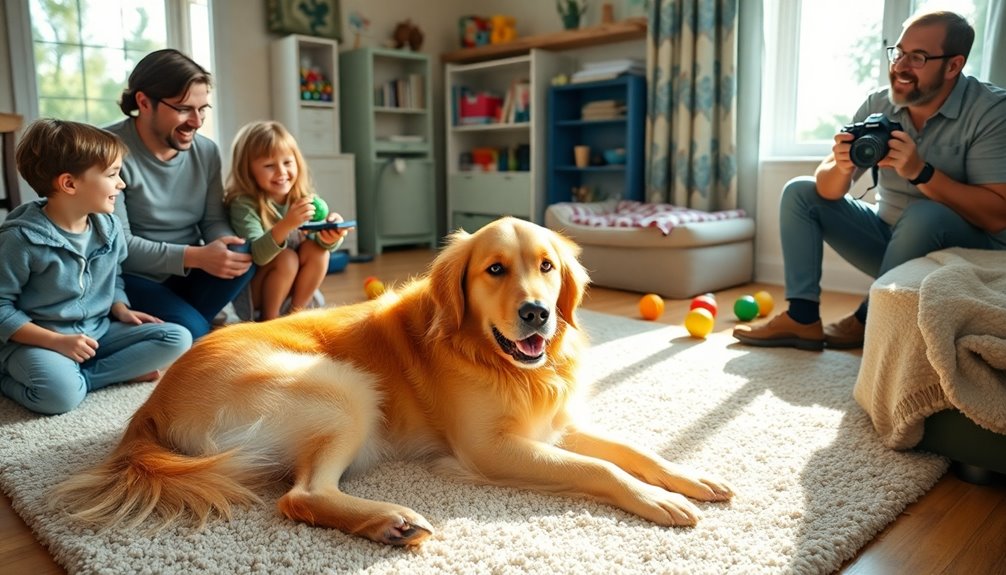
Engaging your family in your dog's care can make all the difference in their happiness and well-being. When everyone pitches in, your dog feels loved and secure, leading to a happy life.
Here are some effective ways to foster family engagement and guarantee your dog gets the attention they deserve:
- Involve Everyone: Encourage each family member to participate in daily dog care tasks like feeding, walking, and grooming. This builds a strong emotional bond.
- Family Activities: Include your dog in family outings or game nights. It promotes social interaction and prevents loneliness, which is essential for their mental health.
- Playdates: Organize regular playdates with other dogs or families. This enhances your dog's social skills and emotional well-being.
- Quality Time: Spend at least 10 minutes each day with your dog, whether it's playing, cuddling, or training. This time reinforces their sense of belonging within the family. Additionally, fostering a culture of experimentation in activities can lead to new ways to engage with your dog, keeping their environment stimulating and enjoyable.
Positive Reinforcement Training
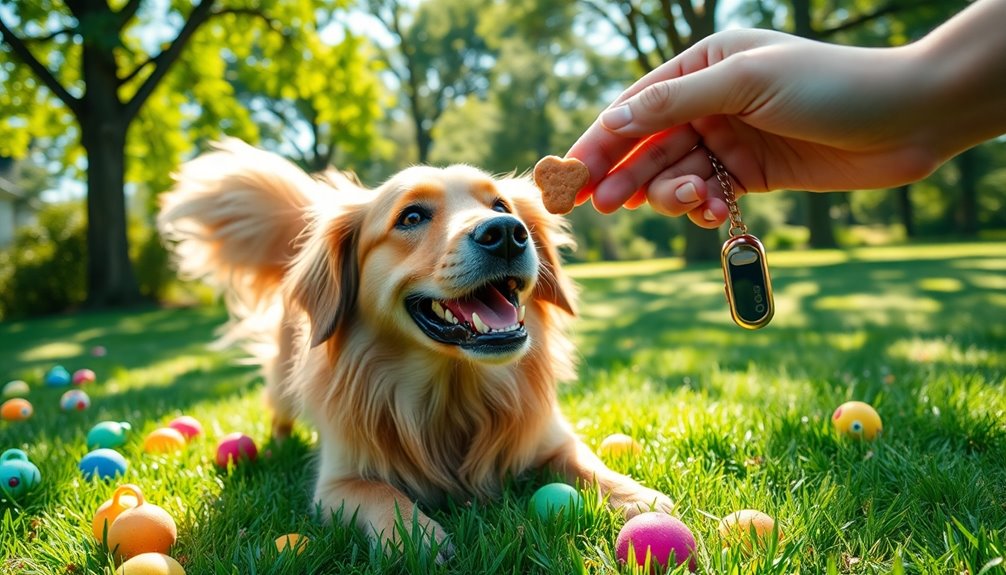
Training your dog with positive reinforcement not only builds good habits but also strengthens the bond between you. This approach uses rewards like treats, praise, or play to encourage desired behaviors, fostering trust in your relationship. Unlike punishment-based methods, positive reinforcement training enhances your dog's willingness to learn while reducing fear and anxiety.
Consistency is key. Use clear commands and provide timely rewards during training sessions. This helps your dog understand expectations and respond more reliably. Every dog learns at its own pace, so be patient and celebrate small victories. Engaging in this type of training improves obedience and offers essential mental stimulation, which contributes to your dog's overall happiness and well-being.
Moreover, regular training sessions deepen the connection between you and your dog. They promote socialization and adaptability in various environments, making outings more enjoyable for both of you.
Frequently Asked Questions
How Do You Tell if a Dog Is Well Cared For?
You can tell if a dog is well cared for by observing its coat, weight, and energy levels.
A shiny coat and healthy weight show proper grooming and nutrition. Regular vet visits guarantee its health is monitored.
Watch for playful behavior and enthusiasm around meal times, which reflect good physical and mental health.
Also, notice how it interacts with others; positive socialization indicates a happy, secure dog in a loving environment.
What Is the 3-3-3 Rule for Dogs?
Imagine your new dog as a ship sailing through uncharted waters. The 3-3-3 Rule outlines their journey through this change.
In the first three days, they may feel lost, showing signs of stress.
By three weeks, they start to unfurl their sails and reveal their personalities, albeit cautiously.
After three months, they're charting their course confidently, fully adapted to their new home.
Understanding this rule helps you support their voyage smoothly.
How Do I Know if I'm Giving My Dog a Good Life?
To know if you're giving your dog a good life, pay attention to their overall behavior and health.
If they're happy, playful, and enthusiastic to eat, you're likely on the right track. Regular vet visits, exercise, and social interactions are key.
A well-groomed dog with a shiny coat shows you're committed to their care.
Most importantly, if your dog feels loved and secure, you're definitely doing a great job!
Do Dogs Know When They Are Well Taken Care Of?
Yes, dogs definitely know when they're well taken care of.
You'll notice their relaxed body language, wagging tails, and playful antics as signs of their contentment. When you provide love, attention, and regular care, they respond with enthusiasm and seek your affection.
Your consistent routines and positive reinforcement make them feel secure and valued.
Conclusion
To sum up, if you're checking off these signs, you're likely a fantastic dog parent! Did you know that dogs who receive regular veterinary care live an average of two years longer than those who don't? By prioritizing their health and well-being, you're not just enhancing their quality of life but also extending the time you get to share together. Keep up the great work, and enjoy every moment with your furry friend!

